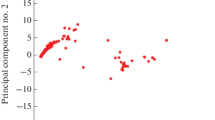Abstract
The application of classification algorithms for malware detection is studied. The classes of activities obtained as a result of clustering are based on analysis of call sequences of WinAPI functions. Application of the following classification algorithms is considered: gradient boosting, adaptive boosting, linear regression, and random forest. To evaluate the operation efficiency of the generated classifiers, the following metrics were employed: accuracy, F1 measure, area under ROC curve, and training time.








Similar content being viewed by others
REFERENCES
The AV-TEST security report 2020. www.av-test.org/fileadmin/pdf/security_report/AVTEST_Security_Report_2019-2020.pdf. Cited March 14, 2021.
Kubrin, G.S. and Ivanov, D.V., Applying machine learning methods to determine phishing sites, Metody Tekh. Sredstva Obesp. Bezop. Inf., 2020, no. 29, pp. 28–30.
Nair, V.P., Jain, H., Golecha, Y.K., Gaur, M.S., and Laxmi, V., MEDUSA: MEtamorphic malware dynamic analysis using signature from API, Proc. 3rd Int. Conf. on Security of Information and Networks, Rostov-on-Don, Russia, 2010, New York: Association for Computing Machinery, 2010, pp. 263–269. https://doi.org/10.1145/1854099.1854152
Tian, R., Islam, R., Batten, L., and Versteeg, S., Differentiating malware from cleanware using behavioural analysis, 5th Int. Conf. on Malicious and Unwanted Software, Nancy, 2010, IEEE, 2010, pp. 23–30. https://doi.org/10.1109/MALWARE.2010.5665796
Salehi, Z., Ghiasi, M., and Sami, A., A miner for malware detection based on API function calls and their arguments, The 16th CSI Int. Symp. on Artificial Intelligence and Signal Processing (AISP 2012), Shiraz, Iran, 2012, IEEE, 2012, pp. 563–568. https://doi.org/10.1109/AISP.2012.6313810
Hansen, S.S. and Larsen, T.M.T., Dynamic malware analysis: Detection and family classification using machine learning, Master’s Thesis, Aalborg: Aalborg Univ., 2015.
Dinh, P.V., Shone, N., Dung, P.H., Shi, Q., Hung, N.V., and Ngoc, T.N., Behaviour-aware malware classification: Dynamic feature selection, 11th Int. Conf. on Knowledge and Systems Engineering (KSE), Da Nang, Vietnam, 2019, IEEE, 2019, pp. 1–5. https://doi.org/10.1109/KSE.2019.8919491
Ognev, R.A., Zhukovskii, E.V., and Zegzhda, D.P., Clustering malicious executable files based on the sequences analysis of system calls, Autom. Control Comput. Sci., 2019, vol. 53, no. 8, pp. 1045–1055. https://doi.org/10.3103/S0146411619080212
Hooked APIs and categories. https://github.com/cuckoosandbox/cuckoo/wiki/Hooked-APIs-and-Categories. Cited March 14, 2021.
Ovasapyan, T.D., Knyazev, P.V., and Moskvin, D.A., Application of taint analysis to study the safety of software of the Internet of Things devices based on the ARM architecture, Autom. Control Comput. Sci., 2020, vol. 54, no. 8, pp. 834–840. https://doi.org/10.3103/S0146411620080246
Ovasapyan, T.D., Danilov, V.D., and Moskvin, D.A., Application of synthetic data generation methods in tasks of detecting network attacks on the Internet of Things, devices, Autom. Control Comput. Sci., 2021, vol. 55, no. 8, pp. 991–998.https://doi.org/10.3103/S0146411621080241
Kalinin, M. and Zegzhda, P., AI-based security for the smart networks, 13th Int. Conf. on Security of Information and Networks, Merkez, Turkey, 2020, New York: Association for Computing Machinery, 2020, pp. 1–4. https://doi.org/10.1145/3433174.3433593
Kalinin, M., Krundyshev, V., and Zegzhda, D., AI methods for neutralizing cyber threats at unmanned vehicular ecosystem of smart city, The Economics of Digital Transformation, Devezas, T., Leitão, J., and Sarygulov, A., Eds., Studies on Entrepreneurship, Structural Change and Industrial Dynamics, Cham: Springer, 2021, pp. 151–171. https://doi.org/10.1007/978-3-030-59959-1_10
Funding
The work was supported by the State Assignment for Fundamental Studies (project no. 0784-2020-0026).
Author information
Authors and Affiliations
Corresponding authors
Ethics declarations
The authors declare that they have no conflicts of interest.
Additional information
Translated by A. Muravev
About this article
Cite this article
Ognev, R.A., Zhukovskii, E.V. & Zegzhda, D.P. Detection of Malicious Executable Files Based on Clustering of Activities. Aut. Control Comp. Sci. 55, 1092–1098 (2021). https://doi.org/10.3103/S0146411621080228
Received:
Revised:
Accepted:
Published:
Issue Date:
DOI: https://doi.org/10.3103/S0146411621080228




